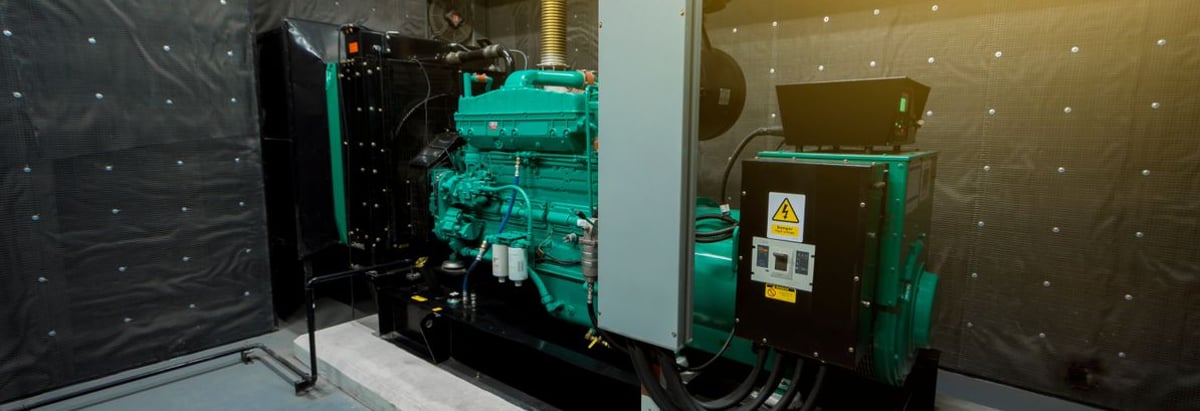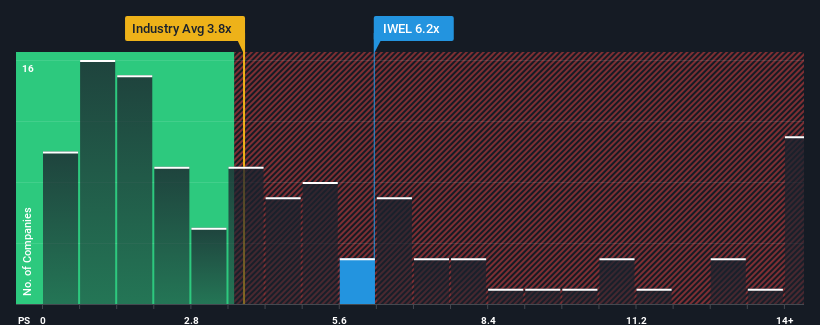- India
- /
- Electrical
- /
- NSEI:IWEL
Inox Wind Energy Limited's (NSE:IWEL) 27% Jump Shows Its Popularity With Investors

Despite an already strong run, Inox Wind Energy Limited (NSE:IWEL) shares have been powering on, with a gain of 27% in the last thirty days. The annual gain comes to 292% following the latest surge, making investors sit up and take notice.
After such a large jump in price, Inox Wind Energy may be sending very bearish signals at the moment with a price-to-sales (or "P/S") ratio of 6.2x, since almost half of all companies in the Electrical industry in India have P/S ratios under 3.8x and even P/S lower than 1.5x are not unusual. Nonetheless, we'd need to dig a little deeper to determine if there is a rational basis for the highly elevated P/S.
Check out our latest analysis for Inox Wind Energy

What Does Inox Wind Energy's P/S Mean For Shareholders?
Inox Wind Energy certainly has been doing a great job lately as it's been growing its revenue at a really rapid pace. The P/S ratio is probably high because investors think this strong revenue growth will be enough to outperform the broader industry in the near future. You'd really hope so, otherwise you're paying a pretty hefty price for no particular reason.
We don't have analyst forecasts, but you can see how recent trends are setting up the company for the future by checking out our free report on Inox Wind Energy's earnings, revenue and cash flow.Is There Enough Revenue Growth Forecasted For Inox Wind Energy?
There's an inherent assumption that a company should far outperform the industry for P/S ratios like Inox Wind Energy's to be considered reasonable.
If we review the last year of revenue growth, the company posted a terrific increase of 133%. The latest three year period has also seen an excellent 174% overall rise in revenue, aided by its short-term performance. Accordingly, shareholders would have definitely welcomed those medium-term rates of revenue growth.
This is in contrast to the rest of the industry, which is expected to grow by 35% over the next year, materially lower than the company's recent medium-term annualised growth rates.
With this in consideration, it's not hard to understand why Inox Wind Energy's P/S is high relative to its industry peers. It seems most investors are expecting this strong growth to continue and are willing to pay more for the stock.
The Final Word
Shares in Inox Wind Energy have seen a strong upwards swing lately, which has really helped boost its P/S figure. Using the price-to-sales ratio alone to determine if you should sell your stock isn't sensible, however it can be a practical guide to the company's future prospects.
We've established that Inox Wind Energy maintains its high P/S on the strength of its recent three-year growth being higher than the wider industry forecast, as expected. Right now shareholders are comfortable with the P/S as they are quite confident revenue aren't under threat. If recent medium-term revenue trends continue, it's hard to see the share price falling strongly in the near future under these circumstances.
And what about other risks? Every company has them, and we've spotted 1 warning sign for Inox Wind Energy you should know about.
It's important to make sure you look for a great company, not just the first idea you come across. So if growing profitability aligns with your idea of a great company, take a peek at this free list of interesting companies with strong recent earnings growth (and a low P/E).
New: AI Stock Screener & Alerts
Our new AI Stock Screener scans the market every day to uncover opportunities.
• Dividend Powerhouses (3%+ Yield)
• Undervalued Small Caps with Insider Buying
• High growth Tech and AI Companies
Or build your own from over 50 metrics.
Have feedback on this article? Concerned about the content? Get in touch with us directly. Alternatively, email editorial-team (at) simplywallst.com.
This article by Simply Wall St is general in nature. We provide commentary based on historical data and analyst forecasts only using an unbiased methodology and our articles are not intended to be financial advice. It does not constitute a recommendation to buy or sell any stock, and does not take account of your objectives, or your financial situation. We aim to bring you long-term focused analysis driven by fundamental data. Note that our analysis may not factor in the latest price-sensitive company announcements or qualitative material. Simply Wall St has no position in any stocks mentioned.
About NSEI:IWEL
Inox Wind Energy
Engages in the manufacture and sale of wind turbine generators (WTGs) in India.
Adequate balance sheet with acceptable track record.
Market Insights
Community Narratives




